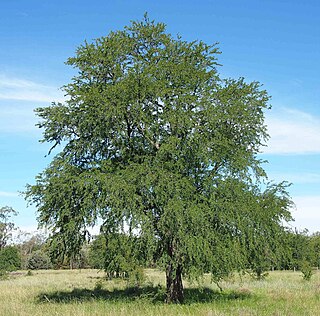Sankowskya is a genus of plants. The sole known species, Sankowskya stipularis, is a tree endemic to one locality in the Wet Tropics rainforests of northeastern Queensland, Australia. The species constitutes part of the plant family Picrodendraceae. Few botanical collections have ever been made of the trees, from a very restricted area of the Wet Tropics rainforests, hence the species has obtained the conservation status of "endangered" in the legislative regulation of the Queensland Government's Nature Conservation Act 1992. Notably, trees grow naturally in the Thylogale Nature Refuge.

Galbulimima is a genus of flowering plants and the sole genus of the family Himantandraceae. Members of the family are found in the tropical zones of eastern Malaysia, the Moluccas, the Celebes, New Guinea, northern Australia and the Solomon Islands.
Romnalda is a genus of monocotyledonous plants in the family Asparagaceae, subfamily Lomandroideae. As of December 2013 four formally named species are known and accepted by botanical science.

Storckiella is a genus of four recognised species of trees, of the plant family Fabaceae. It belongs to the subfamily Dialioideae. They grow naturally in New Caledonia, Fiji and Australia.
Pseuduvaria is a genus of the plant family Annonaceae. It contains the following species:
Bernard Hyland, known as Bernie Hyland, has a long career as an Australian botanist.
Crispiloba is a monotypic genus of flowering plants containing the single species Crispiloba disperma, native to Queensland in Australia. Crispiloba disperma is a shrub species that grows to 4 metres tall. It produces fragrant white flowers followed by purplish ovoid fruits. It occurs in rainforest in North-east Queensland at altitudes ranging from 100 to 1250 metres. The species was first formally described in 1917, based on plant material collected from Mount Bellenden Ker. It was originally given the name Randia disperma and subsequently transferred to the genus Crispiloba in 1984.

Hedraianthera is a genus of a sole recognised species of shrubs or small trees endemic to Australia from the family Celastraceae.

Aneilema acuminatum is a species of herbaceous plant in the family Commelinaceae. It is native to New Guinea, Maluku, Solomon Islands, Queensland, New South Wales. Its natural habitat consists of rainforest, riparian forests and moist areas within drier forests and woodlands.

Acalypha eremorum is a species of shrubs of the plant family Euphorbiaceae, endemic to Queensland, Australia. Commonly known as soft acalypha, turkey bush or native acalypha. The species grows as an open branched shrub to 2 m tall with small leaves with crenate margins. Plants may shed their leaves in response to prolonged drought. Branches often end in spines, especially on smaller plants. Small flowers are produced in spikes throughout the year and are followed by deeply lobed capsular fruit.
Storckiella australiensis is a species of large rainforest legume trees up to 35 m (115 ft) tall, constituting part of the plant family Fabaceae. It has the common name white bean.

Gymnostoma is a genus of about eighteen species of trees and shrubs, constituting one of the four genera of the plant family Casuarinaceae. The species grow naturally in the tropics, including at high altitudes having temperate climates, in forests in the region of the western Pacific ocean and Malesia. In New Caledonia, published botanical science describes eight species found growing naturally, which botanists have not found anywhere else (endemics). Additional species have been found across Burma, Sumatra, Borneo, the Philippines, Sulawesi, Ambon Island, the Moluccas, New Guinea, the Bismarck Archipelago, the Solomon Islands, and one endemic species each in Fiji and the Wet Tropics of Queensland, Australia.
Hollandaea is a genus of four species known to science, of Australian rainforest trees, constituting part of the plant family Proteaceae.
Brassiantha hedraiantheroides is a species of Australian understory shrubs or small trees, constituting part of the plant family Celastraceae. In 2012 botanist Andrew J. Ford formally scientifically named and described them as the first recognised Australian species of the genus Brassiantha. Previously several publications provided informal scientific descriptions of this species under the provisional names "Hedraianthera sp. Mossman Qld Herbarium" or "Hedraianthera sp. Mossman".

Lysiphyllum hookeri is a species of small tree endemic to Queensland, Australia, of the legume plant family Fabaceae. These trees are known by a variety of common names, including pegunny, alibangbang, Hooker's bauhinia, white bauhinia, mountain ebony and Queensland ebony.
Melodinus acutiflorus is a species of vine, commonly named white-flowered melodinus, byamurra, or merangarra and constituting part of the plant family Apocynaceae. They grow naturally in Papua New Guinea, Queensland and New South Wales in Australia.
Synima is a genus of tropical rainforest trees, constituting part of the plant family Sapindaceae.

Lithomyrtus obtusa, commonly known as beach myrtella, is a flowering plant species in the myrtle family, Myrtaceae. It occurs in coastal areas in New Guinea and Queensland, Australia.
Peripentadenia is a genus of two species of large trees from the family Elaeocarpaceae endemic to the rainforests of northeastern Queensland, Australia. Sometimes they have the common name quandong.

Breynia disticha is a plant in the family Phyllanthaceae, first described in 1776. It is native to New Caledonia and Vanuatu in the western Pacific, but naturalized on a wide assortment of other islands around the world, as well as in the U.S. state of Florida.








